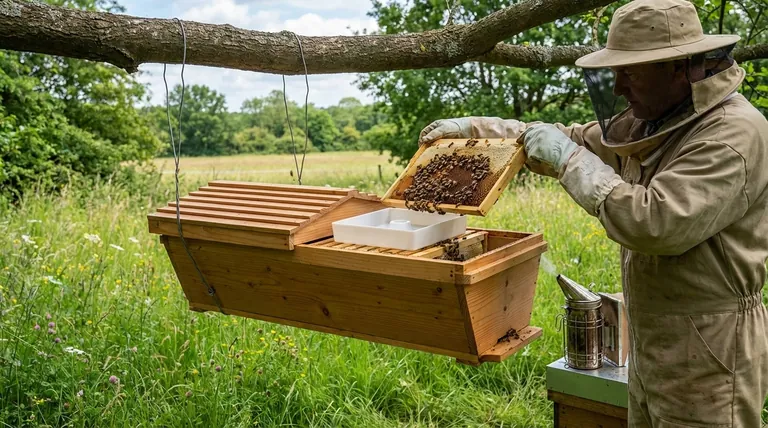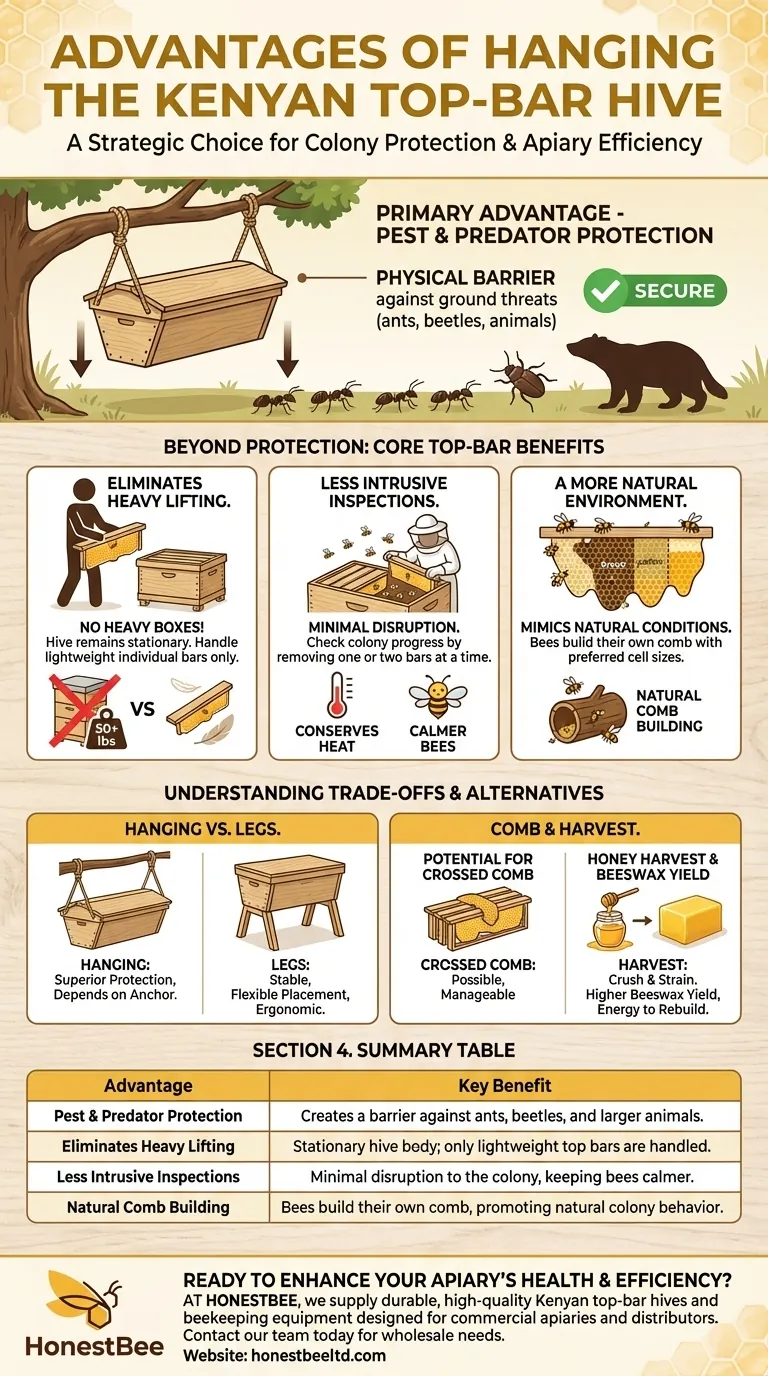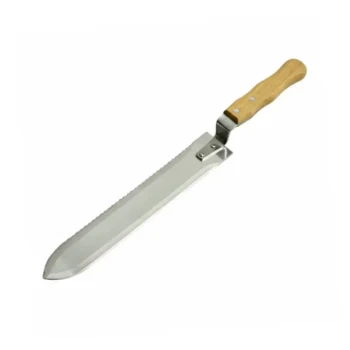The primary advantage of hanging a Kenyan top-bar hive is to create a physical barrier against ground-based threats. By elevating the hive off the ground using wires or ropes, you effectively protect the colony from a range of pests like ants and beetles, as well as from larger domestic and wild animals that could otherwise disturb or destroy it.
While hanging offers crucial protection, it's just one aspect of the Kenyan top-bar hive's core design advantage: a simpler, less physically demanding, and more natural approach to beekeeping compared to traditional stacked hives.

Beyond Protection: The Core Benefits of the Top-Bar Design
The decision to hang a hive is a practical one, but it supports a broader philosophy of beekeeping centered on accessibility and colony health. The horizontal design of the top-bar hive (TBH) itself offers several key benefits.
Eliminating Heavy Lifting
The most celebrated advantage of a TBH is the elimination of heavy lifting. Unlike vertical hives that require lifting heavy boxes (supers) weighing 50 lbs or more, a TBH is managed at a fixed, comfortable height.
Whether hung from a tree or placed on legs, the hive body remains stationary. All work is done by lifting individual top bars, which are light and easy to handle.
Less Intrusive Inspections
Inspections in a TBH are significantly less disruptive to the bees. You only remove one or two bars at a time to check on the colony's progress.
This leaves the vast majority of the hive's "roof" intact, keeping the colony calm, conserving heat, and minimizing defensive behavior from the bees. Many hives also include a viewing window for quick checks without opening the hive at all.
A More Natural Environment for Bees
The TBH system is designed to more closely mimic the conditions of a natural bee colony, such as one found in a hollow log.
Bees build their own comb directly from the top bars without the use of pre-made foundations. This allows them to construct the cell sizes they naturally prefer for brood, pollen, and honey. The horizontal layout also allows the winter cluster to move progressively through their honey stores with less effort.
Understanding the Trade-offs and Alternatives
No hive system is perfect for every situation. Objectivity requires acknowledging the alternatives and potential challenges associated with the top-bar hive.
Hanging vs. Using Legs
Hanging is not the only way to elevate the hive. A sturdy set of legs is a very common alternative that achieves the same ergonomic goal of bringing the hive to waist height.
Hanging provides superior protection from crawling pests, but a well-designed stand offers greater stability and more flexibility in hive placement, as you are not dependent on finding a suitable tree or installing posts.
Potential for Crossed Comb
Because bees build their own comb without the guide of a foundation, they may occasionally attach the comb to the slanted hive walls or across multiple top bars.
This is a manageable issue, especially for attentive beekeepers, but it is a key difference from the rigid structure of a frame-based hive. The slanted "Kenyan" design specifically helps discourage attachment to the side walls.
Honey Harvest and Beeswax Yield
Harvesting honey is simple—you just cut the comb from the bar. However, this "crush and strain" method means the bees must rebuild that comb from scratch, which requires significant energy and resources.
The upside is that this process yields a much larger amount of pure beeswax compared to traditional hives where comb is reused for many years.
Making the Right Choice for Your Goal
Your specific beekeeping goals should inform your hive setup.
- If your primary focus is maximum pest and predator protection: Hanging the hive from a sturdy limb or a purpose-built gantry is the most effective strategy.
- If your primary focus is stability and placement flexibility: A well-built stand with legs is a reliable alternative that still provides all the ergonomic benefits.
- If your primary focus is a low-impact, natural beekeeping experience: The entire Kenyan top-bar system, whether hung or on a stand, is designed to minimize bee disturbance and promote natural colony behavior.
Ultimately, hanging the hive is a tactical choice that enhances the strategic benefits of the entire top-bar system: a more accessible and bee-centric approach to beekeeping.
Summary Table:
| Advantage | Key Benefit |
|---|---|
| Pest & Predator Protection | Creates a barrier against ants, beetles, and larger animals. |
| Eliminates Heavy Lifting | Stationary hive body; only lightweight top bars are handled. |
| Less Intrusive Inspections | Minimal disruption to the colony, keeping bees calmer. |
| Natural Comb Building | Bees build their own comb, promoting natural colony behavior. |
Ready to enhance your apiary's health and efficiency?
At HONESTBEE, we supply durable, high-quality Kenyan top-bar hives and beekeeping equipment designed for the needs of commercial apiaries and distributors. Our wholesale-focused operations ensure you get the reliable supplies you need to protect your colonies and streamline your beekeeping practices.
Contact our team today to discuss your wholesale needs and discover how our equipment can support your success.
Visual Guide

Related Products
- HONESTBEE Professional Hive Top Bee Feeder Feeding Solution
- Professional Hive Top Bee Feeder for Beekeeping
- HONESTBEE Advanced Ergonomic Stainless Steel Hive Tool for Beekeeping
- Professional Engraved Round Hive Number Tags for Beekeeping
- Professional Grade Foldable Beehive Handles
People Also Ask
- How is the plywood floor fitted into the hive-top feeder? Ensure Longevity with a Floating Floor Design
- What safety features are included in top feeders? A Guide to Drowning Prevention and Hive Safety
- How do I keep bees from drowning in my top feeder? Ensure Safe Feeding for Your Hive
- What features make top feeders a reliable choice for beekeepers? A Guide to Safe, Efficient Hive Nutrition
- What are the advantages of hive top feeders? Maximize Feeding Efficiency for Your Apiary



















